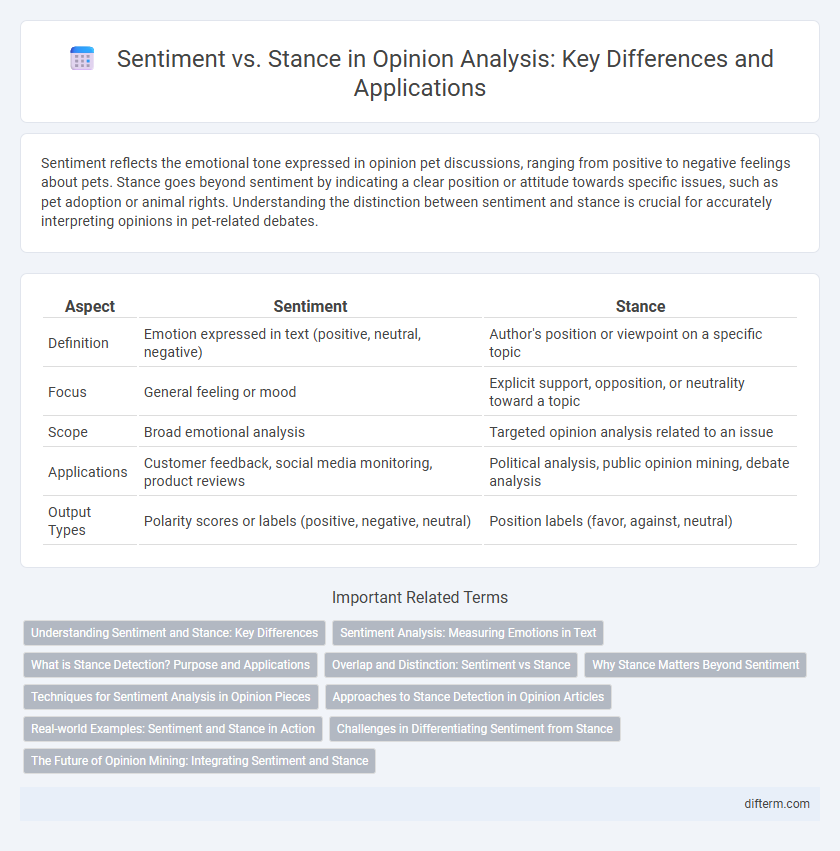Sentiment reflects the emotional tone expressed in opinion pet discussions, ranging from positive to negative feelings about pets. Stance goes beyond sentiment by indicating a clear position or attitude towards specific issues, such as pet adoption or animal rights. Understanding the distinction between sentiment and stance is crucial for accurately interpreting opinions in pet-related debates.
Table of Comparison
| Aspect | Sentiment | Stance |
|---|---|---|
| Definition | Emotion expressed in text (positive, neutral, negative) | Author's position or viewpoint on a specific topic |
| Focus | General feeling or mood | Explicit support, opposition, or neutrality toward a topic |
| Scope | Broad emotional analysis | Targeted opinion analysis related to an issue |
| Applications | Customer feedback, social media monitoring, product reviews | Political analysis, public opinion mining, debate analysis |
| Output Types | Polarity scores or labels (positive, negative, neutral) | Position labels (favor, against, neutral) |
Understanding Sentiment and Stance: Key Differences
Sentiment analysis captures the emotional tone expressed in text, categorizing it as positive, negative, or neutral, while stance detection identifies the author's position or attitude toward a specific topic or claim. Understanding sentiment reveals how people feel, whereas stance provides insight into what they support, oppose, or remain neutral about. Differentiating these concepts enhances accuracy in opinion mining and improves the interpretation of subjective data in natural language processing.
Sentiment Analysis: Measuring Emotions in Text
Sentiment analysis quantifies emotions expressed in text, categorizing opinions as positive, negative, or neutral to gauge public mood and customer feedback. Unlike stance detection, which identifies an author's position on a specific topic, sentiment analysis evaluates the overall emotional tone, providing insights into feelings and attitudes without explicitly stating agreement or opposition. This approach enables businesses and researchers to decode subjective information efficiently, driving decision-making based on emotional trends in large datasets.
What is Stance Detection? Purpose and Applications
Stance detection identifies a speaker's or writer's position toward a specific target, such as support, opposition, or neutrality, distinguishing it from general sentiment analysis that measures overall emotional tone. This process is critical in social media monitoring, political analysis, and market research to understand public opinion and predict behavioral trends. By accurately categorizing stances, organizations can tailor communication strategies, enhance customer engagement, and inform policy decisions with precise insights.
Overlap and Distinction: Sentiment vs Stance
Sentiment reflects the emotional tone expressed toward a subject, typically categorized as positive, negative, or neutral, while stance represents a more deliberate position or viewpoint regarding an issue, often linked to support, opposition, or neutrality. Both concepts overlap when sentiment signals partial stance clues, yet stance analysis demands deeper contextual understanding beyond mere emotional polarity. Distinguishing sentiment from stance enhances opinion mining accuracy, facilitating improved insights in tasks like social media analysis, political discourse, and customer feedback evaluation.
Why Stance Matters Beyond Sentiment
Stance conveys a person's position or viewpoint on an issue, offering deeper insights than sentiment, which merely captures positive or negative emotions. Understanding stance enables more accurate interpretation of opinions in complex debates where emotions alone are insufficient to clarify intent or commitment. This distinction improves tasks like misinformation detection and political analysis by revealing underlying attitudes beyond basic emotional responses.
Techniques for Sentiment Analysis in Opinion Pieces
Sentiment analysis techniques in opinion pieces often employ machine learning models such as support vector machines and deep neural networks to classify emotions expressed in text. Lexicon-based approaches utilize predefined dictionaries of positive and negative words to quantify sentiment polarity. Combining syntactic parsing with context-aware embeddings enhances the detection of nuanced sentiments beyond simple positive or negative labels.
Approaches to Stance Detection in Opinion Articles
Approaches to stance detection in opinion articles leverage machine learning models that analyze textual cues to distinguish sentiment from stance, which refers to the explicit position on a topic rather than just positive or negative feelings. Techniques such as transformer-based models and attention mechanisms enhance accuracy by capturing contextual nuances and author intent. Datasets annotated for stance, paired with sentiment analysis, improve the ability to differentiate between general sentiment expression and specific argumentative positions in opinion writing.
Real-world Examples: Sentiment and Stance in Action
Sentiment analysis measures the emotional tone behind words, capturing whether attitudes are positive, negative, or neutral, as seen in product reviews expressing satisfaction or disappointment. In contrast, stance detection identifies the speaker's position or belief regarding a specific topic, exemplified by social media posts asserting support or opposition to political candidates. Real-world applications like monitoring public opinion during elections demonstrate how sentiment reveals feelings, while stance uncovers explicit endorsements or criticisms.
Challenges in Differentiating Sentiment from Stance
Differentiating sentiment from stance presents significant challenges due to their subtle nuances; sentiment reflects the emotional tone while stance conveys a position on a specific issue. Texts often exhibit ambiguous language where positive or negative sentiment does not straightforwardly indicate support or opposition, complicating automated analysis. Accurate identification requires advanced natural language processing techniques that consider context, implicit meanings, and subjectivity to avoid misclassifications in opinion mining.
The Future of Opinion Mining: Integrating Sentiment and Stance
Integrating sentiment and stance analysis enhances the accuracy of opinion mining by capturing both emotional tone and explicit viewpoints, enabling deeper insights into user-generated content. Advances in natural language processing leverage contextual embedding models to discern nuanced opinions, improving applications from market research to political discourse analysis. The future of opinion mining lies in developing hybrid frameworks that simultaneously assess affective polarity and argumentative positions, providing comprehensive sentiment-stance profiles.
sentiment vs stance Infographic

 difterm.com
difterm.com